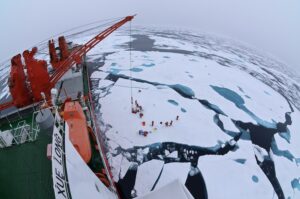China
- History
- Economy
- Arctic Policy
- Recent Publications
- Links
- Experts
China’s northern roots stretch back farther than is generally known. In 1644, the Manchus invaded Beijing from the north, establishing the Qing Dynasty. The Manchus are a Tungusic people whose ancestral homeland lies in Siberia, and their language falls within the same family as Even and Evenki, spoken by the Siberian reindeer-herding peoples of the same names. Some Evenks, who are generally recognized as Arctic indigenous people, still live in pockets of northern China, where some still practice reindeer herding.
More conventionally, China’s involvement in Arctic affairs is said to have commenced in the 1980s when the country began carrying out Arctic and Antarctic expeditions. The Polar Research Institute of China, headquartered in Shanghai, oversees the country’s Arctic research program, which largely concerns sea ice, glacial monitoring, and the atmosphere. In 2004, China opened its Arctic Yellow River Station on Svalbard, where other countries also have research stations; its first overseas satellite receiving station, the China Remote Sensing Satellite North Polar Ground Station, opened in Kiruna, Sweden, in 2016, and the second research station, the China-Iceland Arctic Science Observatory opened in northern Iceland in 2018. China also has four research stations in Antarctica, with a fifth station under construction. China’s Arctic research has grown by leaps and bounds in recent years. In 2012 the Chinese icebreaker, MV Xue Long (Snow Dragon), a Ukrainian Arctic cargo ship refitted in the 1990s in Shanghai, attempted to reach the North Pole in a widely publicized voyage, although it fell short of its goal. China’s second polar research vessel, the MV Xue Long 2, was launched in September 2019. Jointly designed with Finnish icebreaker specialists Aker Arctic and built in Shanghai, the vessel marks a breakthrough in Chinese polar shipbuilding by being the country’s first indigenously-built polar icebreaker.
In 2013, China gained observer status in the Arctic Council alongside Japan, South Korea, Singapore, India, and Italy. More and more Western politicians and media outlets have begun to take notice of the country’s role in the Arctic, often with skepticism or incredulity. However, many Arctic states have welcomed China’s engagement in the region and the potential role it can play as an investor. This is particularly true of Russia, for whom China is a strategic partner. Chinese companies and government agencies, including the China National Petroleum Corporation and the Silk Road Fund, are major shareholders in Novatek’s Yamal LNG project and the former have also invested in subsequent Russian Arctic LNG projects.
This page was updated on 1 August 2022. If we have missed anything, please contact info@thearcticinstitute.org.


